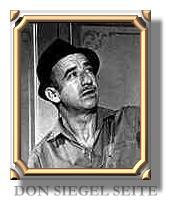 |
Universal - 119 m - USA 1969 |

ANALYSE
LITERATUR
INFOS
 |
Universal - 119 m - USA 1969 |

ANALYSE
LITERATUR
INFOS
| Ein wortkarger amerikanischer Söldner und eine geschwätzige Prostituierte, die sich als Nonne verkleidet hat, kämpfen gegen die Franzosen im revolutionären Mexiko. |
| Shirley MacLaine
Clint Eastwood Manolo Fabregas Alberto Morin John Kelly David Estuardo Ada Carrasco Pedro Galvan José Chavez Enrique Lucero José Angel Espinosa Margarito Luna Pedro Armendariz, Jr. José Chavez Hortensia Santovena Rosa Furman Pancho Cordoba Armando Sylvestre Josh Torvay |
- Sister Sara
- Hogan - Col. Beltran - Gen. LeClaire - Zweiter Amerikaner - Juan - Juans Mutter . - Horacio
- Dritter Amerikaner . - Französischer Offizier - Horatio . . - Juans Vater - Erster Amerikaner |
Don Siegel
Carroll Case Martin Rackin Budd Boetticher Albert Maltz Gabriel Figueroa Ennio Morricone Juan Jose Marino Robert F. Shugrue Jose R.Granada Pablo Galvan Carlos Chavez Helen Colvig Frank Westmore Frank Brendel Leon Ortega Joe Cavalier Buddy Van Horn
|
- Regie
- Produzentin - Produzent - Drehbuch - Drehbuch - Kamera - Musik - Schnitt - Schnitt - Art Director - Set Design - Kostüme - Kostüme - Makeup - Special Effects - Special Effects - Asst. Director - Stunts |
| "There were two things in Two
Mules for Sister Sarah that I'm particularly proud of. One of these things
is something that I didn't even shoot. Joe Cavalier my assistant director,
took a crew into the desert to get the opening credit shots with various
animals in the foreground andclint ridingin the background. I told him what
I wanted and it took him two weeks to get it but it was worth it because
it established a feeling for the kind of animalistic man wh was our hero.
it's one of the best credit sequences I've seen. I also liked the battle sequence, the attack on the fort. It involved a careful scripting of over 70 camera set-ups, from which we took about 120 shots, noe of them on the screen for more than five seconds. i shot it as a montage, right out of my Warner Brothers days. I had every shot tilted in the opposite  direction
from the one before. I worked very hard on making that battle sequence work
because there was really nothing in the story that justified it. My goal
was to make it justify itself by being very exciting. direction
from the one before. I worked very hard on making that battle sequence work
because there was really nothing in the story that justified it. My goal
was to make it justify itself by being very exciting.One regret I have about the picture is that it was a classic ecample of not getting along with the producer. 95% of my time on that picture, and most pictures which I don't produce myself, is spent outwitting, outfoxing, and putting on an act for the producer. Marty Rackin and I did not get along. I'd make my points, but he would walk away saing: 'I lose the battles but win the war': The war he won on Two Mules for Sister Sarah was that he, not I, did the final editin. It's a limited victory, however, because if you cut the picture in the camera, shoot the minimum and get to do the first cut as Alfred Hitchcock does or I do, then there isn't that much leeway in editing the picture unless the producer orders more film shot. Normally the studio has no complaints about my shooting a minimum of film even if it upsets the producer. They grant special dispensations in such cases." (Lovell Interviews, S. 59) |
| "Siegel's improvisations often infuriate writers.
Albert Maltz, author of 'Two Mules for Sister Sara' and co-author (with Irene
Kamp) of 'The Beguiled' told me he thought Siegel had ruined his work, chopping
and changing the scripts for the two films until they were travesties of
the originals. He and Irene Kamp were so angry with Siegel's reworking of
their writing on 'The Beguiled' that they insisted pseudonyms be used on
the picture's credits - John B. Sherry and Grimes Grice. Siegel says: 'Martin Rackin, the producer of 'Two Mules for Sister Sara', a man I despise, and Maltz put the script together and sold it to Clint. They saw it in terms of a crude and stupid burlesque and I had to humanize it. (...) I rewrote most of it, and had several run-ins with Rackin over that." Charles Higham: Suddenly, Don Siegel's High Camp-us. New York Times, 25.7.1971 |
| "In Don Siegels mildem Western
TWO MULES FOR SISTER SARA (Ein Fressen für die Geier - 1970) deutet
sich schon an, daß die unmögliche Sehnsucht dieses Helden darauf
gerichtet ist, von einer Frau 'gezähmt' und vor sich selbst beschützt
zu werden. Weil sich auch dieser inverse patriarchale Traum nicht erfüllen
kann, gibt es in Eastwood-Filmen zwei wiederkehrende Phantasien: Eastwood
wird von einer Fau mit sexueller Gewalt behandelt, er wird immer wieder
gequält und mehr oder minder deutlich kastriert, wird von seiner Freundin
gefesselt in TIGHTROPE (Der Wolf hetzt die Meute - 1984) und von Sonja Braga
in THE ROOKIE (Rookie - Der Anfänger - 1990) vergewaltigt; und
andererseits macht sich Eastwood zum Anwalt, zum Kämper für die
Frau, ein schwarzer Ritter, der die verlorene Ehre der Frauen rächt.
Einer, der eine tiefe Schuld seiner selbst und seines Geschlechts abtragen
muß, indem er die Gewalt, die von Männern gegenüber Frauen
ausgeübt wurde, nun gegenüber den Männern ausübt.
Georg Seeßlen: Selbstbildnis als apokalyptischer Reiter. Clint Eastwood und 'Unforgiven'; in: ders.:Clint Eastwood trifft Federico Fellini. Essays zum Kino. Berlin: Bertz (Edition Splitscreen 2). S. 144/5 |
| ---allmovie---imdb---lexikon des internationalen films--- |